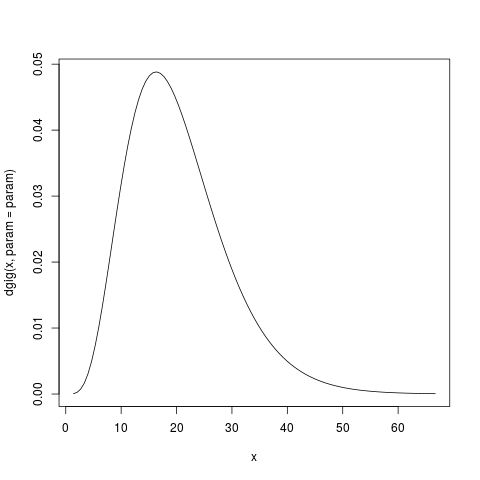Supported by Dr. Osamu Ogasawara and  providing providing  . . |
|
Last data update: 2014.03.03 |
Range of a Generalized Inverse Gaussian DistributionDescriptionGiven the parameter vector param of a generalized inverse Gaussian
distribution, this function determines the range outside of which the density
function is negligible, to a specified tolerance. The parameterization
used is the (chi, psi) one (see
Usage
gigCalcRange(chi = 1, psi = 1, lambda = 1,
param = c(chi, psi, lambda),
tol = 10^(-5), density = TRUE, ...)
Arguments
DetailsThe particular generalized inverse Gaussian distribution being
considered is specified by the value of the parameter value
If If ValueA two-component vector giving the lower and upper ends of the range. Author(s)David Scott d.scott@auckland.ac.nz ReferencesJ<c3><b6>rgensen, B. (1982). Statistical Properties of the Generalized Inverse Gaussian Distribution. Lecture Notes in Statistics, Vol. 9, Springer-Verlag, New York. See Also
Examplesparam <- c(2.5, 0.5, 5) maxDens <- dgig(gigMode(param = param), param = param) gigRange <- gigCalcRange(param = param, tol = 10^(-3) * maxDens) gigRange curve(dgig(x, param = param), gigRange[1], gigRange[2]) ## Not run: gigCalcRange(param = param, tol = 10^(-3), density = FALSE) Results
R version 3.3.1 (2016-06-21) -- "Bug in Your Hair"
Copyright (C) 2016 The R Foundation for Statistical Computing
Platform: x86_64-pc-linux-gnu (64-bit)
R is free software and comes with ABSOLUTELY NO WARRANTY.
You are welcome to redistribute it under certain conditions.
Type 'license()' or 'licence()' for distribution details.
R is a collaborative project with many contributors.
Type 'contributors()' for more information and
'citation()' on how to cite R or R packages in publications.
Type 'demo()' for some demos, 'help()' for on-line help, or
'help.start()' for an HTML browser interface to help.
Type 'q()' to quit R.
> library(GeneralizedHyperbolic)
Loading required package: DistributionUtils
Loading required package: RUnit
> png(filename="/home/ddbj/snapshot/RGM3/R_CC/result/GeneralizedHyperbolic/gigCalcRange.Rd_%03d_medium.png", width=480, height=480)
> ### Name: gigCalcRange
> ### Title: Range of a Generalized Inverse Gaussian Distribution
> ### Aliases: gigCalcRange
> ### Keywords: distribution
>
> ### ** Examples
>
> param <- c(2.5, 0.5, 5)
> maxDens <- dgig(gigMode(param = param), param = param)
> gigRange <- gigCalcRange(param = param, tol = 10^(-3) * maxDens)
> gigRange
[1] 1.400674 66.709821
> curve(dgig(x, param = param), gigRange[1], gigRange[2])
> ## Not run: gigCalcRange(param = param, tol = 10^(-3), density = FALSE)
>
>
>
>
>
> dev.off()
null device
1
>
|
